Retrofit SDR Transceiver
for the Price‑Conscious
Serge Y. Stroobandt, ON4AA
Copyright 2015–2021, licensed under Creative Commons BY-NC-SA
The joy of SDR
Over the last ten years, access to vast computing power has become a relatively cheap common good. This has lead to software defined radio (SDR) getting within reach of most radio amateurs. The personal computer (PC) in your shack is, after all, capable of many more things than just contact logging.
 WebSDR
WebSDR- If you have not played yet with an SDR receiver on HF, you should do so right now. One way to experience SDR first hand is on the Internet where many WebSDR receivers are open to the general public.1 Without any doubt, it will leave you convinced about the great potential of software defined radio, not the least as a new weapon in waging the uphill battle against ubiquitous man-made noise.
Historical lead up
At the time of writing in 2015, a couple of new ham gear brands (Flex Radio, Anan) had pioneered their way in this emerging market of 100 watt HF SDR transceivers. However, at that time, the traditional brands (Yaesu, Icom, TenTec, Kenwood) still had to come with a first baseband SDR offering besides the mediocre IF or audio DSP that was already around.
Even if you were in the market for a new HF transceiver, it was not an easy calling. In a sense, it was still early days for SDR. On one hand, you had an offer of well-designed analog superheterodyne transceivers (like the Elecraft K3S and the Kenwood TS-590SG) with all the buttons and knobs and some DSP at IF and/or AF. On the other hand, you had innovative SDR transceivers that directly sample the entire HF band without any prior frequency conversion. Leaving the Expert Electronics MB1 out of consideration —since it is really an SDR and an ordinary PC sharing the same box,— most of these SDR transceivers are lacking control buttons and dials.
The first game changer might well have been the Icom IC‑7300, introduced in the second quarter of 2016. A couple of years later, the mayor brands finally followed suit.
On proprietary SDR software
Some SDR transceivers employ your PC for the digital signal processing (DSP), while other have their own dedicated DSP processors. Irrespective of this, a number SDR transceivers will only work with proprietary software on a single proprietary operating system (Microsoft Windows™). SDR transceiver firmware, SDR software and the underlying PC operating system may all be closed source and subject to recurring maintenance and licensing fees.
Personally, I have severe reservations with a proprietary approach to SDR. Yes, high price certainly plays a role, but there are more profound reasons as well. One is that I have grown to rely exclusively on GNU/Linux as an operating system. This happened since that spring day in 2006 when a factory installed Windows™ XP turned a brand new, antivirus protected computer into a spam spewing botnet machine. Secondly, only open-source SDR software will allow twenty-first century ham operators to continue to experiment with wireless technology the way they used to do. Anyhow, experimenting is what amateur radio is all about in the first place!
Goal
Because of the previous unavailability of 100 W SDR transceivers with knobs and controls, I refrained from buying a new transceiver at the time and decided to wait it out for more performant and comfortable SDR transceivers to hit the market. Instead, I added a buffered IF1 output to my 1992 Yaesu FT-990 with the intent to feed this signal to a better, off‑board receiver. Subsequent SDR processing is performed by the Linux logging PC in my shack.
My primary goal is improving the signal to interference ratio of the received signal, rather than weak signal reception per se. After all, radio frequency interference (RFI) happens to be the major problem nowadays. Overcrowded bands during contests as well as household, public and industrial equipment not complying with EMC regulations all contribute to RFI. Think: cheap LED lighting, cheap Chinese power supplies, etc.
Software defined radios can produce razor sharp notch and brick wall filters; a feat that is not possible with analogue filters. This comes handy when the interfering signal is within the passband of the signal of interest.
However, strong signals in the vicinity of the passband of the signal of interest may also cause interference, through a process called intermodulation. Intermodulation is caused mainly by 3rd-order harmonics produced within mixers. Both the third-order intercept point (IP3 or TOI) and the 2 kHz 3rd-order dynamic range are most often used as figures of merit to rank receiver immunity to intermodulation. See:
Roofing filters and high quality mixers with little or no (pre-)amplification are what helps best against intermodulation distortion (IMD).
Modern high-performant SDR receivers which are capable of direct sampling the HF spectrum are even less prone to IMD. However, SDR receivers may then again have other issues that are not present with analogue receivers. For example, beating is an often overlooked artefact. Beating occurs when the reconstruction function is a block pulse instead of a cardinal sine waveform and the sampled signal has a frequency right below the Nyquist frequency or folding frequency; i.e. half the sampling frequency.2–4
Transceiver
The modified transceiver is a 1992 Yaesu FT-990 with ROM version 1.30.
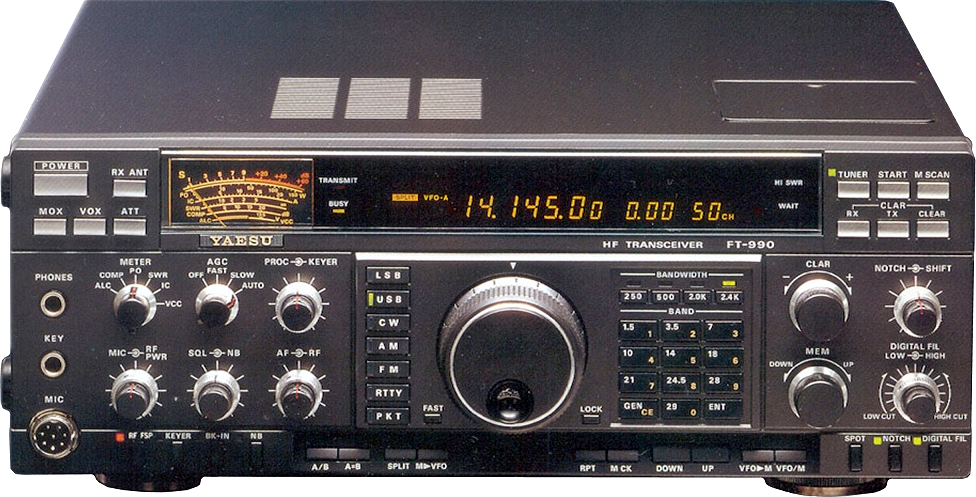
Yaesu FT-990 HF transceiver
IF1 tap
The FT-990 is tapped at the first intermediate frequency (IF1) of 47.210 MHz, after the 40 kHz wide roofing filter and the corresponding IF1 amplifier (Q1013).
Over the years, the quality of the mixers is perhaps what improved most in receivers, aside from any digital filters. The reason why this mod still makes use of the first mixer of the FT-990, is solely for the ease of tuning the transmitter in step with the receiver. However, the IF1 mixer of the FT‑990 will perform much better with this modification than previously. This is because the RF-gain of the FT-990 can be reduced significantly, while the Fun Cube Pro+ can operate its mixer without any mixer gain and still produce sufficient gain at its final amplifier stage. Great!
As explained before, the main goal of this modification is to achieve improved receiver performance, rather than creating a band scope. Tapping behind the IF1 roofing filter results in better in-band interference suppression during contests. This will also increase the signal‑to‑noise ratio for weak signals.
Should rather a wide band scope be desired, then tap the receiver before the IF1 roofing filter.
Block diagram

Block diagram of the Yaesu FT-990 receiver front-end; The 47.210 MHz SDR signal is tapped at the output of the Q1013 IF1 amplifier (between the first and second block from the left).
RF unit
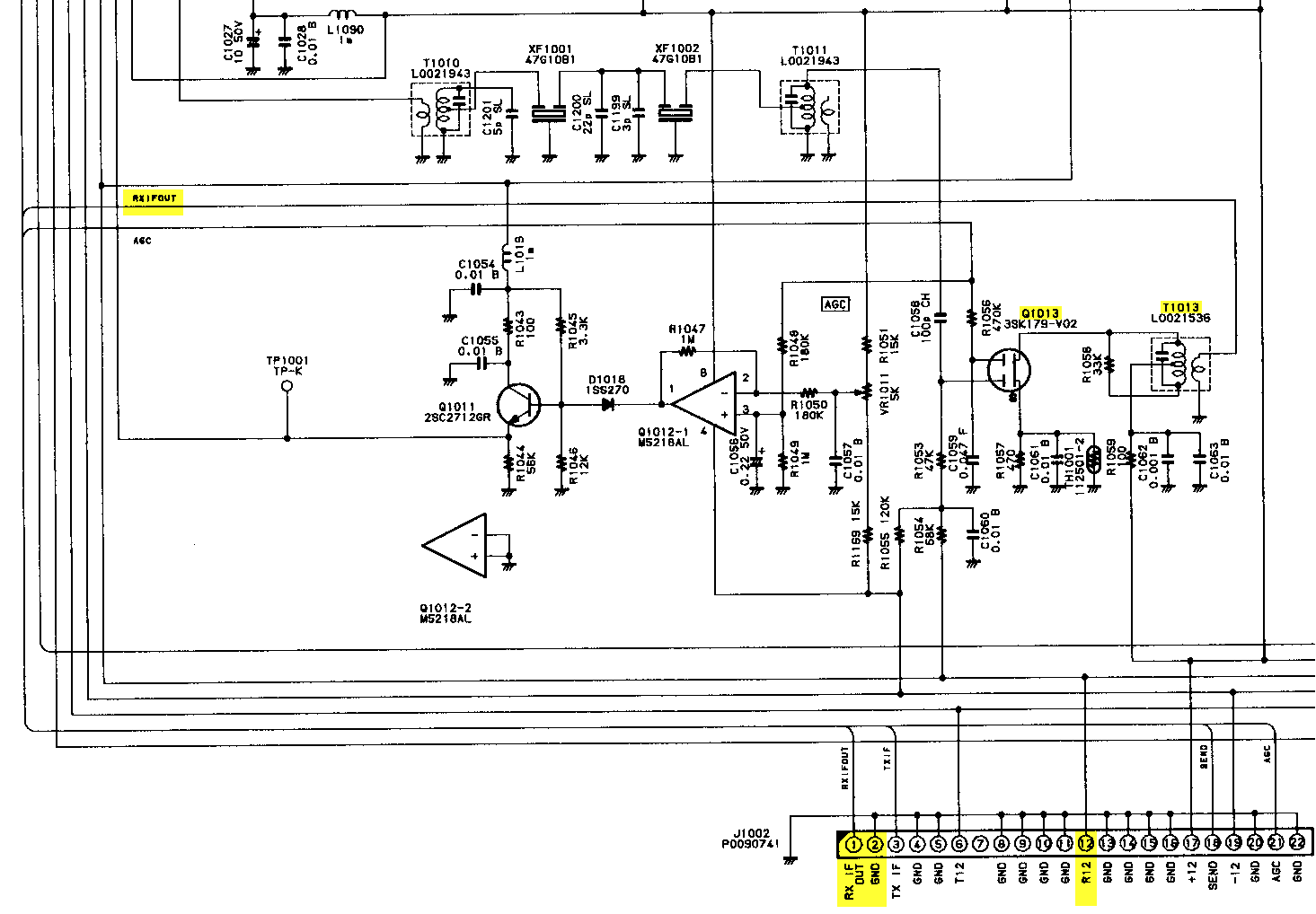
Schematic detail of the Yaesu FT-990’s RF unit, showing jumper J1002, RF transformer T1013 and transistor Q1013
T1013
| pin № | label | description |
|---|---|---|
| 1 | RXIFOUT | IF1 RX output at 47.210 MHz |
| 2 | GND | transceiver ground |
| 12 | R12 | 12V on receive |
The receiver of the FT‑990 resembles the second receiver of the FT‑1000.
Buffer amplifier
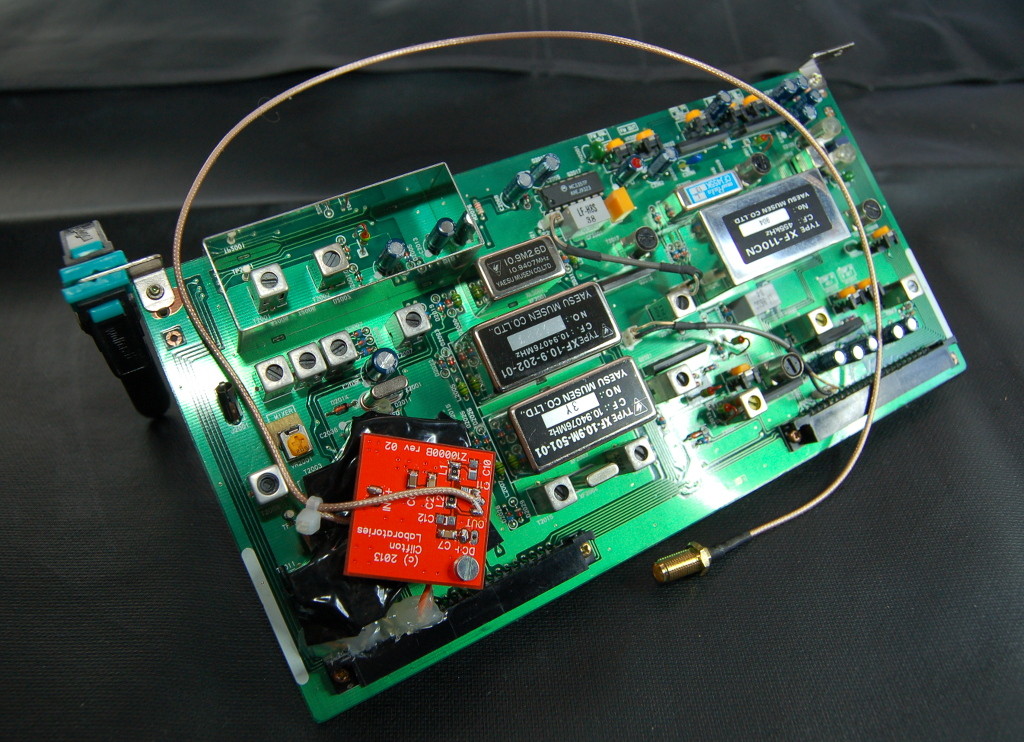
Yaesu FT-990 RF unit tapped at IF1 with the Z10000B‑U buffer amplifier (red printed circuit board). A number of inductor cannisters beneath the buffer amplifier were taped off as a precaution against short circuits. Cable strain relief is provided by a tie wrap and some hot glue.
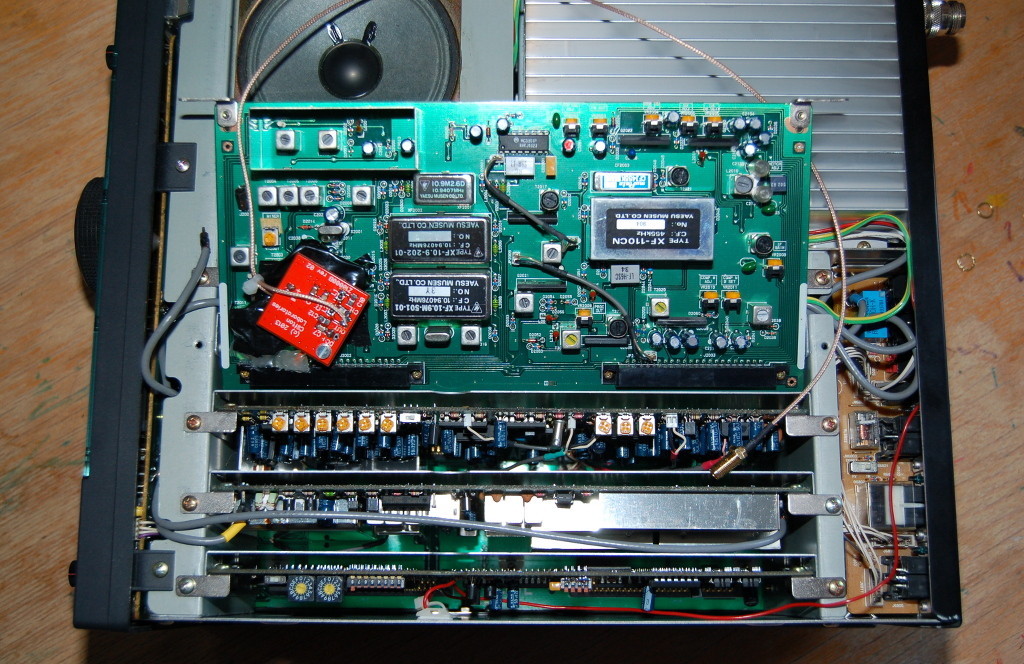
The RF unit board retrofitted with the IF1 tap fits snugly within the innards of the Yaesu FT-990 HF transceiver.
Clifton Laboratories Z10000B‑U transimpedance buffer amplifier Since IF1 with 47.210 MHz is relatively high, the Z10000B‑U buffer amplifier is built to deliver more bandwidth at the cost of a lower nett nominal gain of only +6.7 dB. This implies that the Z10000B‑U is assembled with a value for R7 = 150R. R5 is kept at the default value of 4K7.
Down‑converter and sampler
The FUNcube Dongle Pro+ is a programmable down-converter and 192 kHz sampler with a high performant mixer, amplifiers and surface acoustic wave (SAW) filters. It boasts the following specifications:
- Guaranteed frequency range: 150 kHz to 240 MHz and 420 MHz to 1.9 GHz
- Typical frequency coverage: 150 kHz to 260 MHz and 410 MHz to 2.05 GHz
- TCXO specified at 0.5 ppm (in practice about 1.5 ppm)
- 192kHz sampling rate
- Extremely simple hardware setup, just two connections, an “in” and an “out”:
- Standard SMA female antenna port
- USB 1.x type A male connection
- Eleven discrete hardware front end filters including:
- 6 MHz 3 dB bandwidth (10 MHz at -40 dB) SAW filter for the 2 m band.
- 20 MHz 3 dB bandwidth (42 MHz at -40 dB) SAW filter for the 70 cm band
- Third- and fifth-order LC bandpass filters for other bands
- Front end LNA OIP3 30 dB
- Typical noise figures:
- 50 MHz 2.5 dB
- 145 MHz 3.5 dB
- 435 MHz 3.5 dB
- 1296 MHz 5.5 dB
- Typical NFM 12 dB SINAD measurements:
- 145 MHz 0.15 µV
- 435 MHz 0.15 µV
- No additional drivers required for Linux, OSX or Windows
- Integrated 5 V bias T switchable from software
Again, at the time of writing, there were not many Linux-compatible SDR receivers around. The FUNcube Dongle Pro+ was one of a few affordable options available in Europe. Nowadays, more alternatives exist, such as the SDRplay RSP1A.
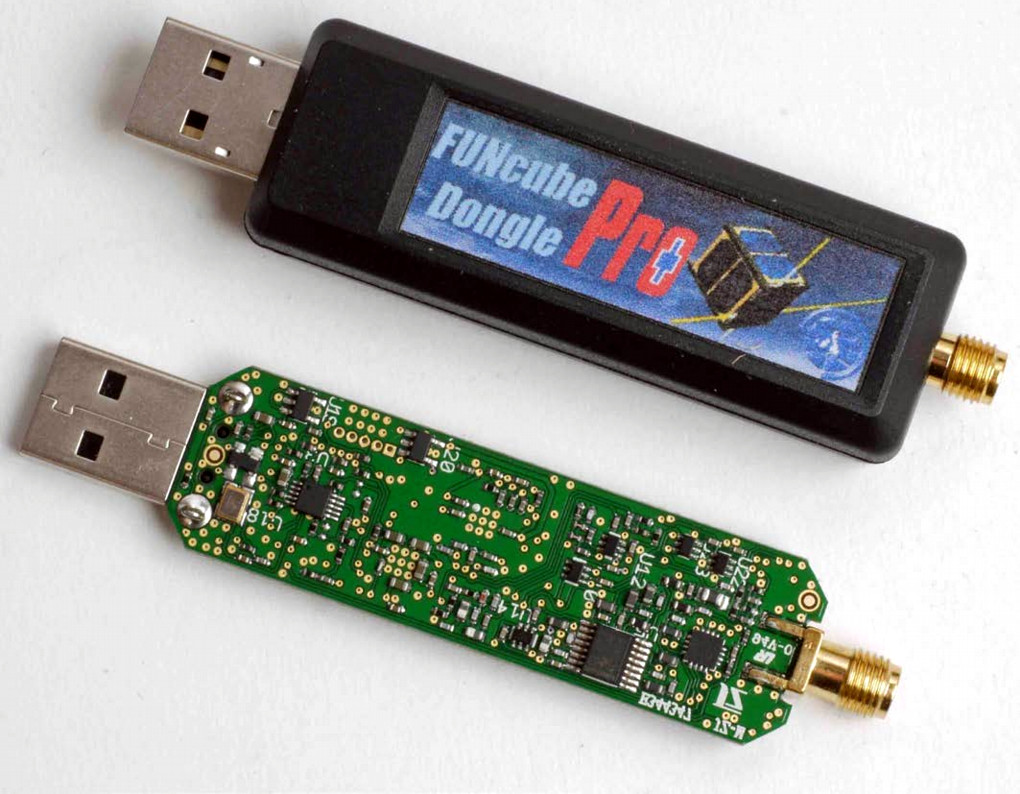
The FUNcube Dongle Pro+ with and without its plastic housing.
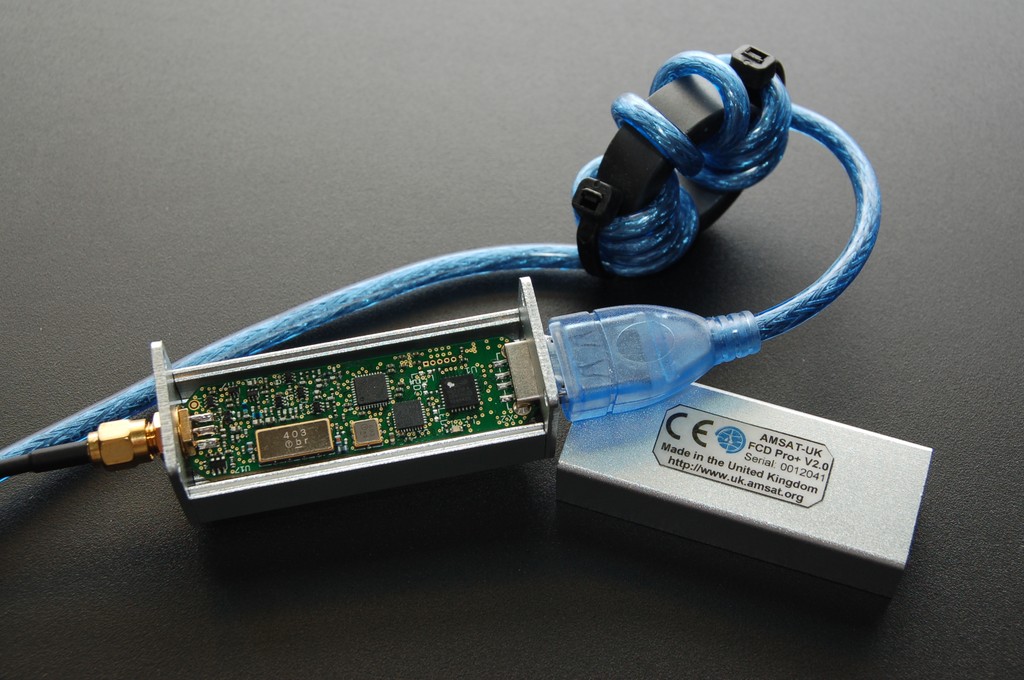
The FCD Pro+ received a new shielded housing. Spinning the USB cable ten times over a FT-140-43 ferrite core results in an effective sheath current choke, keeping PC noise out.
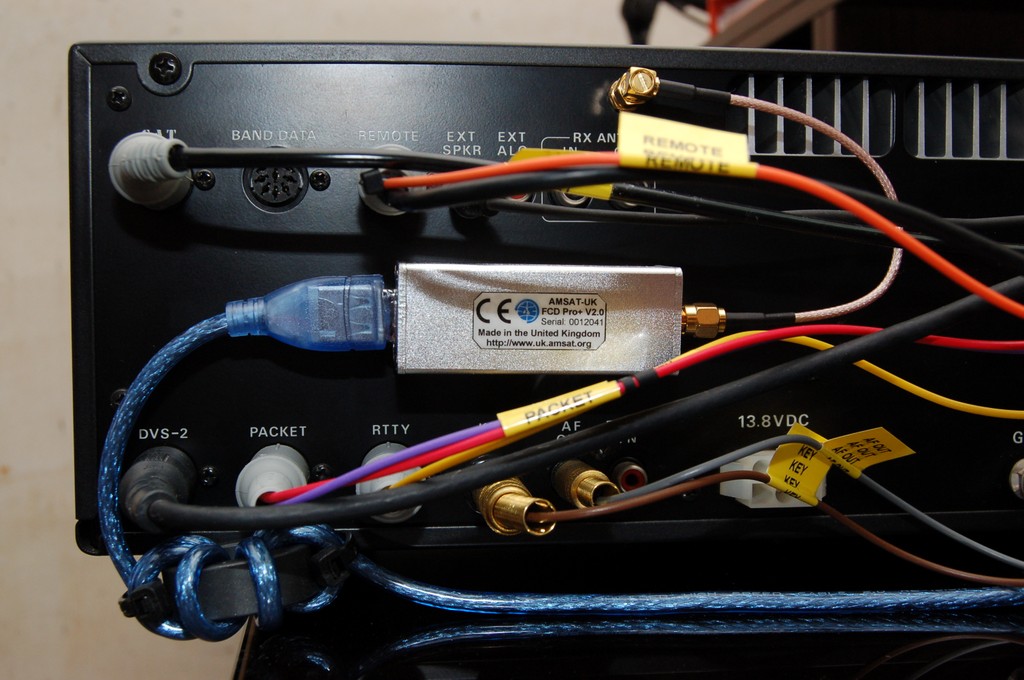
The shielded FUNcube Dongle Pro+ mounted on the modified Yaesu FT‑990 with a strip of 3M™ Dual Lock™ hook & loop fastener.
Firmware upgrade
Upgrade the FUNcube Pro+ firmware with Qthid, available as qthid-fcd-controller in Debian derived GNU/Linux distributions.
USB Isolator
Software defined radios are usually connected to a computer over USB. However, doing so creates a ground loop between the radio and the computer which will pick up noise during receive. Breaking this ground loop calls for an USB isolator. Several readily available USB isolators are designed around the ADuM3160 chip data sheet evaluation board.
I acquired a USB isolator branded Amsamotion for about €15 off Aliexpress. I chose this model because it comes housed in a sturdy case. However, a simple continuity test revealed the respective shields of the USB cables at both ends of the isolator are connected! This defies the whole purpose of a USB isolator. Luckily, the case can be pried open to destroy the offending PCB trace (see pictures).
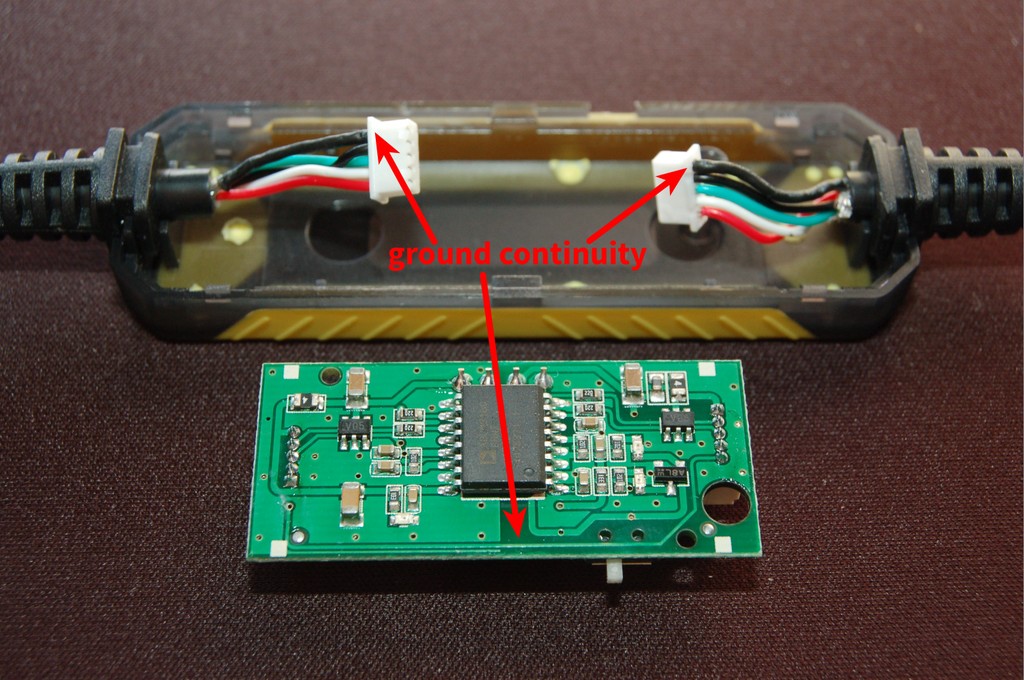
Amsamotion USB isolator with an undesired ground continuity
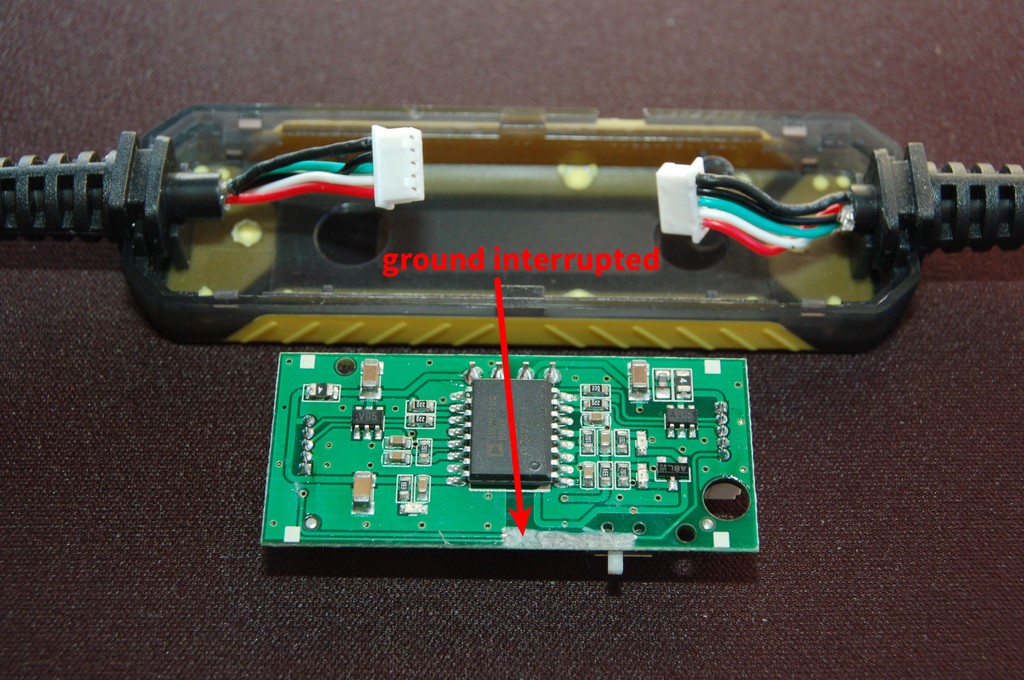
Amsamotion USB isolator with interrupted ground
Answer from Amsamotion:
Thank you. Good suggestion.
We checked with our engineer and your suggestion is correct.
We will change the PCB design of the new product batch. Thank you!
Hope to hear more goods comments from you in the near future!
Dagang Fu
April 8, 2019Computer
A 2008 vintage Intel Core 2 Duo E8500 on a GIGABYTE GA EP45T‑UD3R motherboard with 4× 2GB 1600MHz 7‑7‑7‑20 DDR3 RAM are sufficient to run gqrx, CQRLOG, wsjtx and a couple of browsers. All hardware was bought second-hand on eBay. The motherboard features eight USB 2.0 ports, which comes very handy in any radio shack. Everything was mounted in a nice new case. I completed the PC build with a 250 GB solid‑state drive and a NVIDIA GeForce® 9500GT graphics card.
SDR software
By now, you should know that I am picky about OS
gqrx employs GNU Radio components.
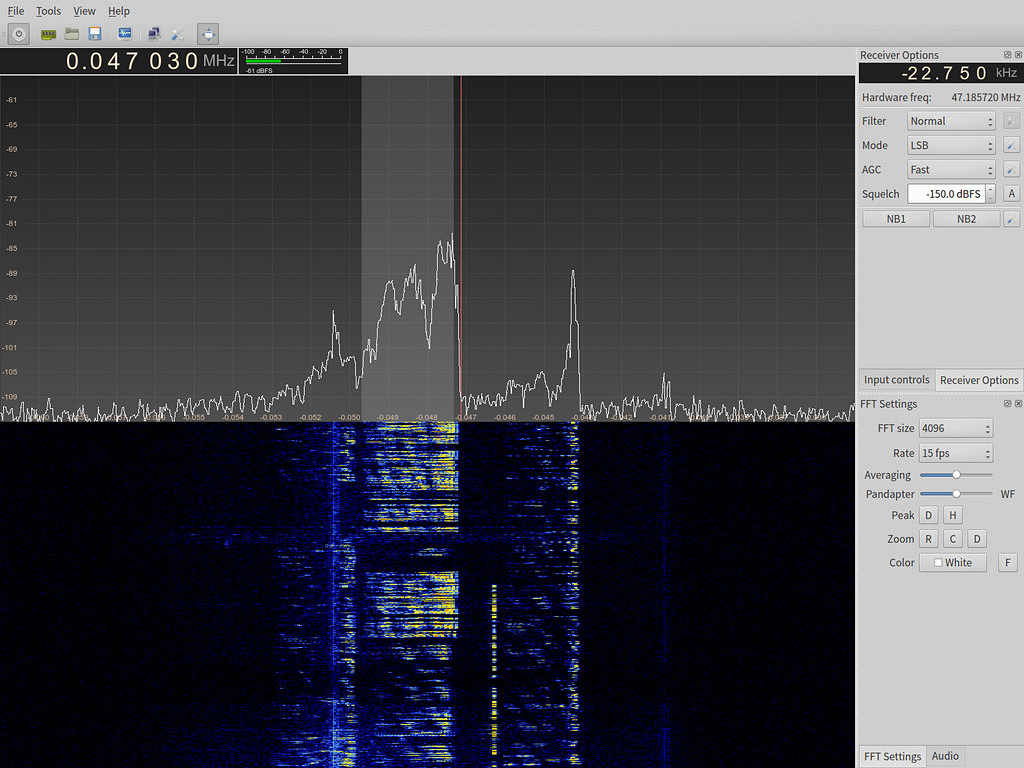
About 16 kHz of low-noise pass band at 47 MHz is available for demodulation by gqrx. The dial of the FT-990 transceiver is used to tune through the HF spectrum. Razor-sharp bandpass filtering by gqrx keeps nearby interference at bay.
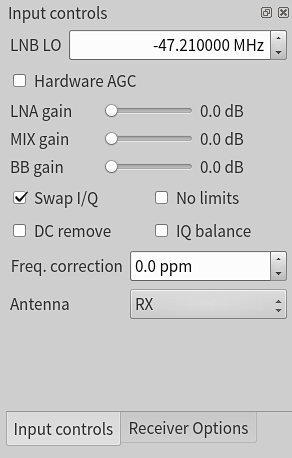
Best results are obtained by setting the RF gain of both the transceiver and the various FUNCube Dongle Pro+ stages (LNA, MIX & BB) to an absolute minimum. FCD Pro+ gain settings can be configured through the gqrx software.
First impressions
Here are my first impressions for SSB signals:
- The FT-990’s RF gain in front of its first mixer can be reduced to a level where the FT-990 will no longer produce any sound whereas the FUNcube Pro+ will still demodulate. Third order IMD is largely attributed to unlinearity in the RF gain stage and the first mixer, so this certainly will have a very positive impact on 3rd order IMD.
- I can hear weak signals with the FUNcube Pro+ which I cannot hear with the FT-990, even if I increase the RF gain back up again.
- Depending on the employed SDR software, one now will be able to use DSP bandpass and notch filters, much sharper than those of the FT-990.
- With reduced RF-gain, the S-meter on the FT-990 no longer produces any useful information. This is a flaw inherent to the FT-990’s design, and not a result of this modification.
Other FT-990 modifications
TX 1.8–30MHz
Close JP5002 on the control unit with a solder blob.
References

This work is licensed under a Creative Commons Attribution‑NonCommercial‑ShareAlike 4.0 International License.
Other licensing available on request.

Unless otherwise stated, all originally authored software on this site is licensed under the terms of GNU GPL version 3.
This static web site has no backend database.
Hence, no personal data is collected and GDPR compliance is met.
Moreover, this domain does not set any first party cookies.
All Google ads shown on this web site are, irrespective of your location,
restricted in data processing to meet compliance with the CCPA and GDPR.
However, Google AdSense may set third party cookies for traffic analysis and
use JavaScript to obtain a unique set of browser data.
Your browser can be configured to block third party cookies.
Furthermore, installing an ad blocker like EFF's Privacy Badger
will block the JavaScript of ads.
Google's ad policies can be found here.
transcoded by
 .
.


